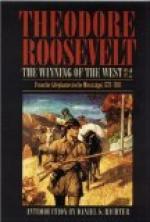On the last day of the month they met Col. Richard Henderson, who had just come out and was running the line between Virginia and North Carolina. The crews were so exhausted that the progress of the boats became very slow, and it was not until April 24th that they reached the Big Salt Lick, and found Robertson awaiting them. The long, toilsome, and perilous voyage had been brought to a safe end.
There were then probably nearly five hundred settlers on the Cumberland, one half of them being able-bodied men in the prime of life. [Footnote: Two hundred and fifty-six names are subscribed to the compact of government; and in addition there were the women, children, the few slaves, and such men as did not sign.] The central station, the capitol of the little community, was that at the Bluff, where Robertson built a little stockaded hamlet and called it Nashborough [Footnote: After A. Nash; he was the governor of North Carolina; where he did all he could on the patriot side. See Gates MSS. Sept. 7, 1780.]; it was of the usual type of small frontier forted town. Other stations were scattered along both sides of the river; some were stockades, others merely block-houses, with the yard and garden enclosed by stout palings. As with all similar border forts or stations, these were sometimes called by the name of the founder; more rarely they were named with reference to some natural object, such as the river, ford, or hill by which they were, or commemorated some deed, or the name of a man the frontiersmen held in honor; and occasionally they afforded true instances of clan-settlement and clan-nomenclature, several kindred families of the same name building a village which grew to be called after them. Among these Cumberland stations was Mansker’s (usually called Kasper’s or Gaspers—he was not particular how his name was spelled), Stone River, Bledsoe’s, Freeland’s, Eatons’, Clover-Bottom, and Fort Union.
As the country where they had settled belonged to no tribe of Indians, some of the people thought they would not be molested, and, being eager to take up the best lands, scattered out to live on separate claims. Robertson warned them that they would soon suffer from the savages; and his words speedily came true—whereupon the outlying cabins were deserted and all gathered within the stockades. In April roving parties of Delawares, Chickasaws, and Choctaws began to harass the settlement. As in Kentucky, so on the banks of the Cumberland, the Indians were the first to begin the conflict. The lands on which the whites settled were uninhabited, and were claimed as hunting-grounds by many hostile tribes; so that it is certain that no one tribe had any real title to them.
Formation of a Government.




